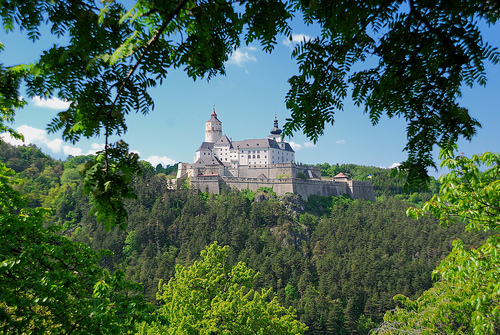

Location: Forchtenstein, Burgenland Map
Constructed: 15th century
Open: 8am- 12pm, 1-4pm daily Apr- Oct
weekdays Mar- Nov
Tel. (02626) 81212
Official site
Forchtenstein Castle is a medieval fortress in the Burgenland province in the Eastern Austria. Forchtenstein Castle was constructed in the 15th century by the Lords of Mattersburg who later were known as Lords of Forchtenstein. They kept its citadel as a site for a treasury as well as hold control of the area. Unfortunately the armies of Ottoman Turks apparently discovered its primary purpose and tried to storm Forchtenstein Castle on several occasions. They failed, unable to take impregnable fort. Over the course of the 17th century Nikolaus Esterházy and his son made extensive additions to the citadel's defenses to keep up with the improving firearm technology under supervision of Simon Retacco and later Domenico Carlone. During these renovations a new protected treasure vault was constructed. It was intended to store weapons, archives, machines and exotic animal preparations. Over time location was forgotten and was rediscovered only during World War II during reconstruction project. Today Forchtenstein Castle is open to the public. It houses one of the largest collections of the medieval weaponry in Europe.
The castle stands southwest of Mattersburg above the Wulka valley.
The first part of the castle with the 50 m high keep was built at the
beginning of the 14th century by the Lords of Mattersdorf, who later
called themselves Lords of Forchtenstein.
The Lords of
Forchtenstein died out around 1450 due to a lack of male descendants and
the castle came into the possession of the Habsburgs, who owned it for
170 years and pledged it to the Counts of Weißbriach and Hardegg, among
others. The fortress then fell to Archduke Albrecht VI. and thus briefly
became an important part of a small Habsburg principality.
During
this period of time not much changed at the castle. In 1622 Nikolaus
Esterházy, ancestor of the Esterházy, received the castle from Emperor
Ferdinand II in exchange, and the Esterházy received the title of count.
Nikolaus began to expand the now dilapidated castle into a fortress. In
the years 1630 to 1634 he concluded work contracts with the Viennese
master builder Simone Retacco and from 1643 with the pallier Domenico
Carlone for the new construction of the castle. The builders were all
Italians. It was a large order for three Kaisersteinbrucher masters,
Ambrosius Petruzzy, Pietro Maino Maderno and Mathias Lorentisch. Kaiser
stone was used for main portals, fountains, cannonballs, etc. The carved
stones were delivered in large stone wagons pulled by six oxen.
His son Paul continued to expand the castle in the second half of the
17th century according to the plans of the architect Domenico Carlone,
with emphasis also being placed on artistic design. Due to the many
conversions, the castle is actually a baroque castle in its current
size. After Paul's death, the purpose of the castle changed. From the
previous fortress, it became a repository for weapons, the princely
archives and the princely collection of clocks, automatons, exotic
taxidermy and other "miracles". The so-called treasury and miracle
chamber could only be reached via a secret passage; the door could only
be opened with two different keys. One was kept by the prince and the
other by the treasurer. These rooms were also not discovered during the
occupation period after the Second World War and were thus preserved
intact. In addition to the actual collection, the cupboards with the
original glass panes are also important (see illustration). In the
second half of the 18th century, the castle was expanded by master
builder Johann Ferdinand Mödlhammer. The roof truss was lifted and the
interior renovated.
In 1919, during the Hungarian Soviet
Republic, around 280 objects from the Esterházy treasury in
Forchtenstein were confiscated by state officials and taken to Budapest,
where they are to this day. After the end of the Soviet Republic, the
Hungarian state concluded a loan agreement for these objects with
Esterházy; since, in the opinion of the Esterházy Private Foundation,
Hungary will no longer fully comply with this in 2019, the foundation is
endeavoring to have its objects returned.
The castle is owned by
the Esterházy Private Foundation and, alongside the Esterházy Palace in
Eisenstadt, shows the history and treasures of the old noble family.
After the Esterházy estates were separated into a Hungarian and an
Austrian part in 1921, the economic archive material remained in
Forchtenstein Castle, while the family archive has since been kept in
the Hungarian State Archives in Budapest.
The Forchtenstein
Castle Games took place annually from 1954 to 1983 at Forchtenstein
Castle.